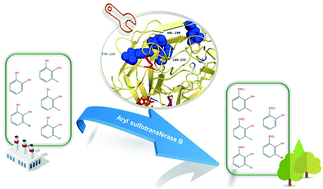Loop engineering of aryl sulfotransferase B for improving catalytic performance in regioselective sulfation†
Abstract
Catechol sulfates act in our body as important antioxidants and often have anti-inflammatory properties. Enzymatic sulfation of catechol as well as substituted catechols by aryl sulfotransferases opens up an environmentally-friendly route for chemo- and/or regioselective sulfation. This study focuses on reengineering of loop12 and loop13 of aryl sulfotransferase B (ASTB) from Desulfitobacterium hafniense in order to improve the sulfate transfer efficiency of six catechols. The obtained ASTB variants were generated in a KnowVolution campaign using the random mutagenesis method SeSaM and the multi-site saturation method OmniChange. The catalytic activity (kcat) and catalytic efficiency (kcat/KM) of the final variant ASTB-OM2 (Q191Y/Y218W/L225V) were improved for all six investigated catechols when compared to ASTB-WT (e.g., 13.6-fold improvement of kcat for 3-bromocatechol). HPLC-MS analysis confirmed the improved sulfate stoichiometry of ASTB-OM2 with a transfer efficiency up to 94% for 3-methylcatechol in comparison to 24% for ASTB-WT. A molecular understanding of the improved sulfation activity of ASTB-OM2 was achieved through molecular docking studies and electron effects of catechol substituents were analyzed by Hammett equation.



 Please wait while we load your content...
Please wait while we load your content...